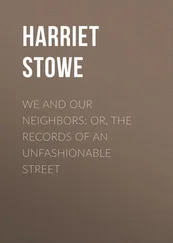Harriet Stowe - Household Papers and Stories
Здесь есть возможность читать онлайн «Harriet Stowe - Household Papers and Stories» — ознакомительный отрывок электронной книги совершенно бесплатно, а после прочтения отрывка купить полную версию. В некоторых случаях можно слушать аудио, скачать через торрент в формате fb2 и присутствует краткое содержание. Жанр: foreign_prose, на английском языке. Описание произведения, (предисловие) а так же отзывы посетителей доступны на портале библиотеки ЛибКат.
- Название:Household Papers and Stories
- Автор:
- Жанр:
- Год:неизвестен
- ISBN:нет данных
- Рейтинг книги:3 / 5. Голосов: 1
-
Избранное:Добавить в избранное
- Отзывы:
-
Ваша оценка:
- 60
- 1
- 2
- 3
- 4
- 5
Household Papers and Stories: краткое содержание, описание и аннотация
Предлагаем к чтению аннотацию, описание, краткое содержание или предисловие (зависит от того, что написал сам автор книги «Household Papers and Stories»). Если вы не нашли необходимую информацию о книге — напишите в комментариях, мы постараемся отыскать её.
Household Papers and Stories — читать онлайн ознакомительный отрывок
Ниже представлен текст книги, разбитый по страницам. Система сохранения места последней прочитанной страницы, позволяет с удобством читать онлайн бесплатно книгу «Household Papers and Stories», без необходимости каждый раз заново искать на чём Вы остановились. Поставьте закладку, и сможете в любой момент перейти на страницу, на которой закончили чтение.
Интервал:
Закладка:
“Trust you for that, Mary! By the bye, I’ve found a nice little woman, who has worked on upholstery, who will come in by the day, and be the hands that shall execute the decrees of your taste.”
“Yes, I am sure we shall get on capitally. Do you know that I’m almost glad we can’t get new things? It’s a sort of enterprise to see what we can do with old ones.”
“Now, you see, Mary,” said John, seating himself on a lime-cask which the plasterers had left, and taking out his memorandum-book, – “you see, I’ve calculated this thing all over; I’ve found a way by which I can make our rooms beautiful and attractive without a cent expended on new furniture.”
“Well, let’s hear.”
“Well, my way is short and simple. We must put things into our rooms that people will look at, so that they will forget to look at the furniture, and never once trouble their heads about it. People never look at furniture so long as there is anything else to look at; just as Napoleon, when away on one of his expeditions, being told that the French populace were getting disaffected, wrote back, ‘Gild the dome des Invalides ,’ and so they gilded it, and the people, looking at that, forgot everything else.”
“But I’m not clear yet,” said Mary, “what is coming of this rhetoric.”
“Well, then, Mary, I’ll tell you. A suit of new carved black-walnut furniture, severe in taste and perfect in style, such as I should choose at David & Saul’s, could not be got under three hundred dollars, and I haven’t the three hundred to give. What, then, shall we do? We must fall back on our resources; we must look over our treasures. We have our proof cast of the great glorious head of the Venus di Milo; we have those six beautiful photographs of Rome, that Brown brought to us; we have the great German lithograph of the San Sisto Mother and Child, and we have the two angel heads, from the same; we have that lovely golden twilight sketch of Heade’s; we have some sea photographs of Bradford’s; we have an original pen-and-ink sketch by Billings; and then, as before, we have ‘our picture.’ What has been the use of our watching at the gates and waiting at the doors of Beauty all our lives, if she hasn’t thrown us out a crust now and then, so that we might have it for time of need? Now, you see, Mary, we must make the toilet of our rooms just as a pretty woman makes hers when money runs low, and she sorts and freshens her ribbons, and matches them to her hair and eyes, and, with a bow here and a bit of fringe there, and a button somewhere else, dazzles us into thinking that she has an infinity of beautiful attire. Our rooms are new and pretty of themselves, to begin with; the tint of the paper, and the rich coloring of the border, corresponding with the furniture and carpets, will make them seem prettier. And now for arrangement. Take this front room. I propose to fill those two recesses each side of the fireplace with my books, in their plain pine cases, just breast-high from the floor: they are stained a good dark color, and nobody need stick a pin in them to find out that they are not rosewood. The top of these shelves on either side to be covered with the same stuff as the furniture, finished with a crimson fringe. On top of the shelves on one side of the fireplace I shall set our noble Venus di Milo, and I shall buy at Cicci’s the lovely Clytie, and put it the other side. Then I shall get of Williams & Everett two of their chromo lithographs, which give you all the style and charm of the best English watercolor school. I will have the lovely Bay of Amalfi over my Venus, because she came from those suns and skies of southern Italy, and I will hang Lake Como over my Clytie. Then, in the middle, over the fireplace, shall be ‘our picture.’ Over each door shall hang one of the lithographed angel heads of the San Sisto, to watch our going out and coming in; and the glorious Mother and Child shall hang opposite the Venus di Milo, to show how Greek and Christian unite in giving the noblest type to womanhood. And then, when we have all our sketches and lithographs framed and hung here and there, and your flowers blooming as they always do, and your ivies wandering and rambling as they used to, and hanging in the most graceful ways and places, and all those little shells and ferns and vases, which you are always conjuring with, tastefully arranged, I’ll venture to say that our rooms will be not only pleasant, but beautiful, and that people will oftener say, ‘How beautiful!’ when they enter, than if we spent three times the money on new furniture.”
In the course of a year after this conversation, one and another of my acquaintances were often heard speaking of John Morton’s house. “Such beautiful rooms, – so charmingly furnished, – you must go and see them. What does make them so much pleasanter than those rooms in the other house, which have everything in them that money can buy?” So said the folk; for nine people out of ten only feel the effect of a room, and never analyze the causes from which it flows: they know that certain rooms seem dull and heavy and confused, but they don’t know why; that certain others seem cheerful, airy, and beautiful, but they know not why. The first exclamation, on entering John’s parlors, was so often “How beautiful!” that it became rather a byword in the family. Estimated by their mere money value, the articles in the rooms were of very trifling worth; but, as they stood arranged and combined, they had all the effect of a lovely picture. Although the statuary was only plaster, and the photographs and lithographs such as were all within the compass of limited means, yet every one of them was a good thing of its own kind, or a good reminder of some of the greatest works of art. A good plaster cast is a daguerreotype, so to speak, of a great statue, though it may be bought for five or six dollars, while its original is not to be had for any namable sum. A chromo lithograph of the best sort gives all the style and manner and effect of Turner or Stanfield, or any of the best of modern artists, though you buy it for five or ten dollars, and though the original would command a thousand guineas. The lithographs from Raphael’s immortal picture give you the results of a whole age of artistic culture, in a form within the compass of very humble means. There is now selling for five dollars at Williams & Everett’s a photograph of Cheney’s crayon drawing of the San Sisto Madonna and Child, which has the very spirit of the glorious original. Such a picture, hung against the wall of a child’s room, would train its eye from infancy; and yet how many will freely spend five dollars in embroidery on its dress, that say they cannot afford works of art!
There was one advantage which John and his wife found, in the way in which they furnished their house, that I have hinted at before: it gave freedom to their children. Though their rooms were beautiful, it was not with the tantalizing beauty of expensive and frail knick-knacks. Pictures hung against the wall, and statuary safely lodged on brackets, speak constantly to the childish eye, but are out of the reach of childish fingers, and are not upset by childish romps. They are not, like china and crystal, liable to be used and abused by servants; they do not wear out; they are not spoiled by dust, nor consumed by moths. The beauty once there is always there; though the mother be ill and in her chamber, she has no fears that she shall find it all wrecked and shattered. And this style of beauty, inexpensive as it is, compared with luxurious furniture, is a means of cultivation. No child is ever stimulated to draw or to read by an Axminster carpet or a carved centre-table; but a room surrounded with photographs and pictures and fine casts suggests a thousand inquiries, stimulates the little eye and hand. The child is found with its pencil, drawing, or he asks for a book on Venice, or wants to hear the history of the Roman Forum.
Читать дальшеИнтервал:
Закладка:
Похожие книги на «Household Papers and Stories»
Представляем Вашему вниманию похожие книги на «Household Papers and Stories» списком для выбора. Мы отобрали схожую по названию и смыслу литературу в надежде предоставить читателям больше вариантов отыскать новые, интересные, ещё непрочитанные произведения.
Обсуждение, отзывы о книге «Household Papers and Stories» и просто собственные мнения читателей. Оставьте ваши комментарии, напишите, что Вы думаете о произведении, его смысле или главных героях. Укажите что конкретно понравилось, а что нет, и почему Вы так считаете.












